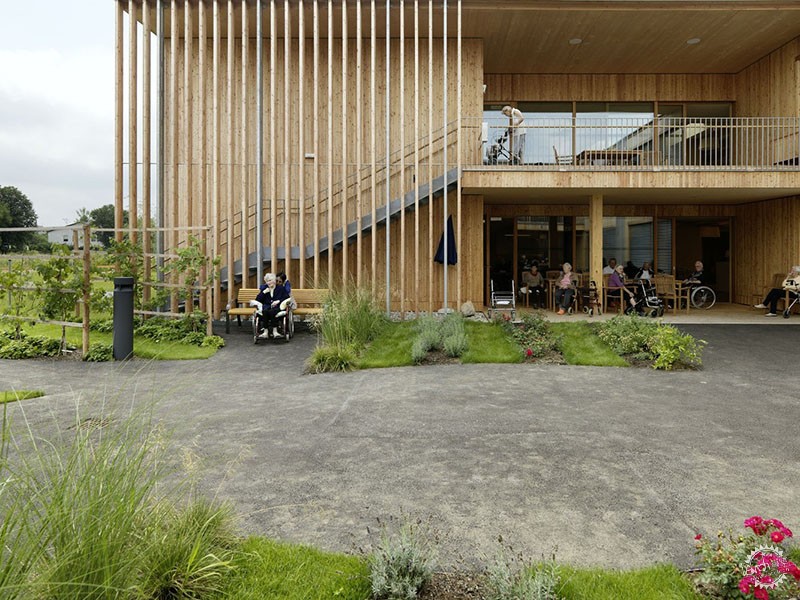
Peter Rosegger Nursing Home / Dietger Wissounig Architekten. Image © Paul Ott
如何为老年人设计建筑
How To Design for Senior Citizens
由专筑网李韧,吴静雅编译
人口老龄化的现象正在世界范围内发生,在这里,我们之所以称之为“现象”,是因为人口金字塔正在逐步发生着逆转,这意味着出生率在逐年下降,与此同时,预期寿命则在增加。因此,老年人口的增长速度比儿童要快许多。
巴西地理统计研究所(Brazilian Institute of Geography and Statistics——IBGE)调查得出,在2017年,巴西60岁以上的人口数量至少为3000万,这占了人口总数的14.6%。为了更好地了解人口增长,那么就来看一下其他国家/地区的人口数。墨西哥的人口总数约为2800万,相当于澳大利亚和新西兰的人口总合,我们谈论的是一个国家大小的人口统计。
The population’s aging phenomenon is occurring worldwide. We say phenomenon because all population pyramids are reversing, which means birth rates are steadily decreasing over the years, and at the same time, life expectancy has been increasing. Thus, the elderly population is growing at a faster rate than children.
According to IBGE (Brazilian Institute of Geography and Statistics), in 2017 there were more than 30 million people over the age of 60 in Brazil (14.6% of the population). To understand this growing demographic, let's take a look at other countries' statistics. Mexico's total population is about 28 million, the size of Australia's and New Zealand's combined population. We are talking about a demographic the size of a country.

Cortesia de Flavia Ranieri
这些数据的问题在于其中的比例,诸如法国这样的发达国家大约花了115年的时间来实现人口结构的转变,但像中国这样的发展中国家却用了了约27年的时间[1],这就是我们常常所说的人口结构快速转变,这说明发达国家可以通过针对老年人的服务、政策、基础设施来进行调整,而发展中国家却存在对这些个人照顾不足的情况。因此,在发展中国家的老年人生活品质较低。
The issue with these statistics is the rate at which we have reached these numbers. While developed countries such as France took 115 years to make this demographic shift, developing countries such as China took around 27 years [1]. It’s what we call a rapid demographic transition. That means that while developed countries could gradually prepare themselves by adapting services, politics, and infrastructures dedicated to an older population, developing countries are in a situation where there is not enough care for these individuals. Thus, a lower quality of life for our elders.

Cortesia de Flavia Ranieri
那么,该如何定义老年人?在巴西,60岁以上的人就是老人,在发达国家,这个数字通常超过65岁。如果能够按照年龄来进行定义,那么问题就很容易解决,但是事实却并非如此。
老年生活状况是环境的发展结果,根据世界卫生组织(World Health Organization——WHO)的调查,六项指标会对我们的年龄产生影响,分别是社会、经济、行为、个人、社会认可度、健康服务,以及物质环境。活跃的个体或是对个体有伤害的因素都能够促使人们提前步入老年[2]。因此,保持老年人的身体健康和活跃程度非常必要。
And who are they? In Brazil, a person over 60 years old is considered an elder, while in developed countries it is usually over 65. It would be easy if defining people was as simple as that, by age. But it isn’t.
Our old age is the result of our environment and the choices we have made. According to the WHO (World Health Organization), six items influence how we will age. These determinants are social, economic, behavioral, personal, the available social and health services, and the physical environment. We can reach old age as active individuals or as having an advanced level of frailty that compromises our functional abilities [2]. To keep the elderly population healthy and active is a necessity and not a luxury.

Cortesia de Flavia Ranieri
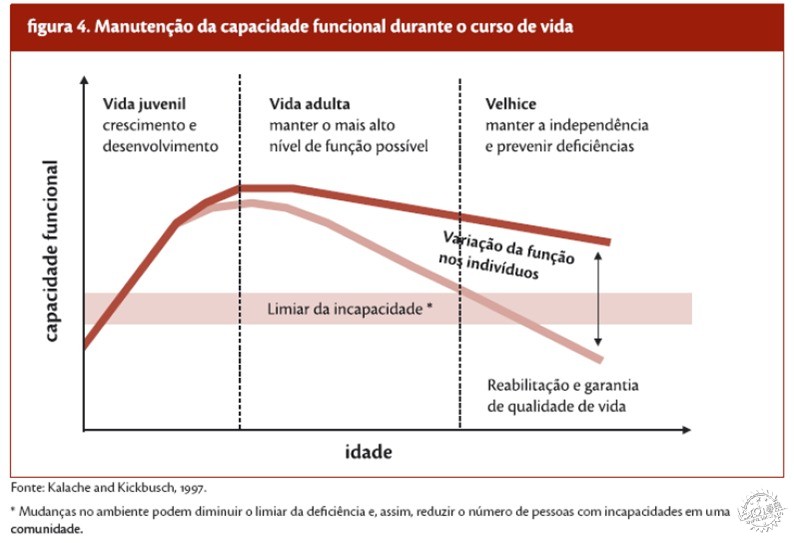
Cortesia de Flavia Ranieri
那么我们该如何保持老年人的活跃呢?当前有四大支柱:健康、继续教育、社会参与和安全,以及保护。
而建筑师和城市规划者在此方面就可以做出诸多贡献,例如公共政策,亦或是物质环境。同时我们也可以就宏观城市规模与微观住宅项目而努力。
而就城市而言,关键问题便是可行性、公共交通、社会服务。圣保罗大学(USP)近期的一项研究报告分析了公交线路、地铁、火车、老年人与残疾人专属车位、救济等级、圣保罗城市服务与零售场所的可行性数据[3]。调查结果显示,扩大化城市中心有着很好的条件,Bráz则位列其首,其次是República和Sé,最后是Iguatemi、José Bonifácio、 Cachoeirinha地区。如果我们将这些数据与老年人数最多的地区进行交叉,就能够制定出有针对性和高效的改善计划,但同时这也依赖于政治意愿,因此需要一些社会压力,使它们成为现实。
But how do we keep the elderly population active? There are four pillars that are currently considered: health, continued learning and education, social participation and security, and protection.
As architects and urban planners, there is a lot we can contribute, be it on the public policy front or directly in the physical environment. We can work with the macro scale of cities and the small scale of dwellings.
Regarding cities, the most important problems are related to accessibility, public transportation, and services. A recent study from USP (Sao Paulo University) analyzed the databases of bus lines, subway, and trains, senior and disabled people exclusive parking spaces; relief and grade; as well as the accessibility of service and retail establishments in the city of Sao Paulo [3]. It is clear from the findings that the expanded city center offers better conditions, Bráz being the first district on the list, followed by República and Sé. In the last positions, we find the districts of Iguatemi, José Bonifácio, and Cachoeirinha. To see the entire rank, access this link. If we cross this data with the districts that have the largest number of older people, it is possible to draw a focused and efficient improvement plan. We rely a lot on political will, but our associations can add pressure to make them a reality.

Maggie’s Manchester / Foster + Partners. Image © Nigel Young Foster + Partner
2012年,圣保罗有一个名为“老年友好城市”项目,但是直到2018年1月,这个项目才开始真正执行。现在有670座城市在国内研究和推广各项举措。市政厅相关人员说:“当前,市政厅社会援助网络有134项针对老年人的特定服务,例如日间活动与会议中心,以及特别的居住中心和长期居住机构。总的来说,这些场所的服务人次约为1.5万人。”[4]但是很少有人考虑到这座城市有约140万老年人,这对于建筑师和城市规划者而言,是一个巨大的领域。
为了提升老年人的生活质量,联合国还推出了“城市的老龄友好标准——核心功能使用指南” [5]。在物理环境方面,列出了以下条例:
- 土地规划与利用;
- 公共空间与公共建筑设计;
- 住宅设计与成本选择;
- 交通方式设计。
在这些项目中,我们应当考虑城市的交通方式、公共空间、建筑、交通工具的可达性,以及住房安全性。因为这些方面都会影响到老年人的幸福指数。在网上就可以查到许多设计指导。
而针对那些寻求实用和重点的人来说,世界卫生组织列出了关于物质方面的建议清单[6]。
In 2012, the State of Sao Paulo created a program called “the elderly-friendly city,” but it was only until January 2018 that the city has adhered to it. Now there are 670 cities studying and promoting initiatives in the State. “Currently, the City Hall’s social assistance network has 134 specific services aimed for the elderly, such as Day Centers and Reference Centers for daytime activities, and special Living Centers and long-stay institutions for refuge. Together, these centers serve about 15 thousand people” [4], says the City Hall. It is little considering that the city is home to around 1.4 million elders; a huge field for architects and urban planners.
To aid the quest for better quality of life for the elderly in cities, the United Nations launched the guide “Measuring the age-friendliness of cities – A guide to using core indicators” [5]. When it comes to the physical environment, it lists the following items:
- Planning and land use
- Public space and public buildings design
- Housing design and cost options
- Means of transportation design
Among these items, we should consider the ability to traverse the city, the accessibility of public spaces, buildings, and means of transportation, and the ability to afford housing and security. All these items impact the health and well-being of the elderly. Many guides found online can be used as a starting point in the creation of one’s own.
For those in search of something practical and to the point, this is the check-list suggested by WHO [6] when it comes to physical aspects.
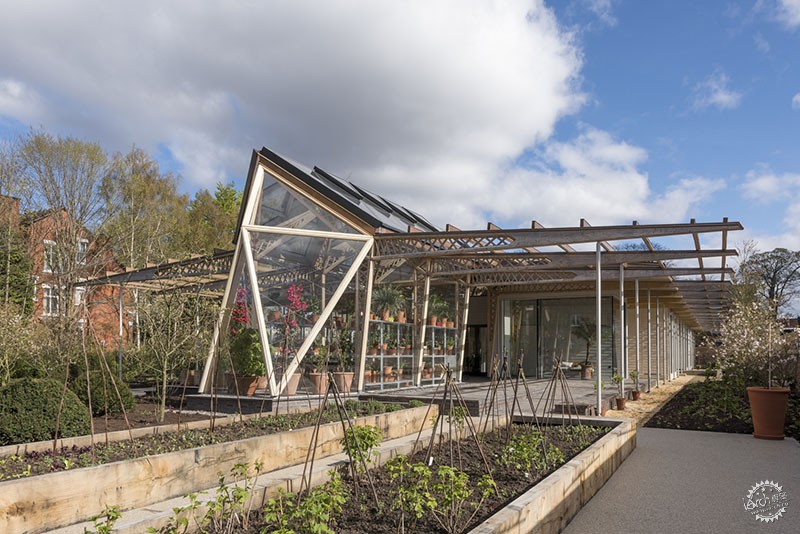
Maggie’s Manchester / Foster + Partners. Image © Nigel Young Foster + Partner
空间与建筑的外部区域
- 公共空间应当保持干净;
- 提供安全和保养良好的座位和绿化区域;
- 铺设人行道、无障碍、行人专用设施;
- 防滑地板足够宽敞,适合轮椅使用者。 适应进入道路的路缘。;
- 适应不同需求的安全通道,其中设置有防滑装置、自动视觉通信信号标、以及足够的穿越时间。;
- 行人优先;
- 人车分离;
- 良好的照明、警察监督与服务和社区教育;
- 无服务死角;
- 特殊的顾客服务系统,例如特定的等待区域;
- 建筑内外设置有明确的标识系统,有充足的座椅、卫生间、电梯、坡道和可通行的楼梯;
- 室内外都有充足且干净的公用厕所。
External Areas of Spaces and Buildings
- Public spaces should be clean and pleasant.
- Provide safe and well-kept seats and green areas.
- Paved sidewalks, free of obstacles, and exclusive to pedestrians.
- Anti-slipping flooring wide enough for a wheelchair. Curbs adapted to access the roadway.
- Safe crosswalks adapted to different needs, having anti-slipping paving, visual and audio communication signals, and adequate crossing time.
- Pedestrians must have priority in crossings.
- Bike lanes separated from the pedestrian area.
- Good lighting, police surveillance, and community education.
- Services should be placed near each other and accessible.
- Special customer service, such as separate waiting lines.
- Good signage inside and outside of buildings, with enough seats and bathrooms, lifts, ramps and accessible stairs.
- Enough public toilets in external and internal areas, in good conditions.
住宅
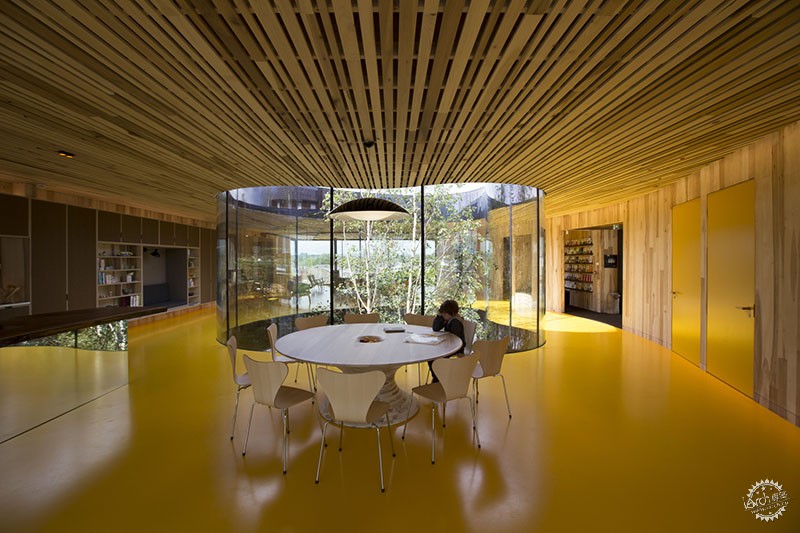
Maggie’s Oldham / dRMM. Image © Alex de Rijke
- 在安全地区及邻近地区提供足够的社会福利住房和社区支援;
- 经济适用的维护服务与支持;
- 设计优良、便捷安全的住房设施;
- 舒适、安全、自由的室内空间;
- 经济适用的住房改造;
- 价格适中、条件优良的租房条件;
- 保障老年人健康的经济适用房,以及便捷的服务设施。
老年建筑设计较为复杂,主要需要考虑两方面因素,即情绪和健康安全。
住宅不仅仅是一座居所,也是人们塑造自己生命的场所,是每个人在这个世界上的专属角落[7]。同时也是记忆、经历、未来梦想的发生场所[8]。人们从这里开始自我认识。
《规约》第三十七条规定“老年人有权拥有舒适的住宅,同时拥有健康的家庭和陪伴,亦或是为之服务的私人与公共机构。”如果一位健康的老年人希望独自居住,你必须给予他们这个权利。由于对家庭的恐惧,有的人会忽视这项权利,但是优良的社会支持系统则能够克服这些问题。
Housing
- Enough affordable housing in safe areas and near services and community support.
- Affordable maintenance services and support.
- Well built and designed housing, providing safety, comfort, and shelter.
- Accessible interiors guaranteeing free movement in all rooms and corridors.
- Renovating housing for the elderly population needs to affordable.
- Public and private affordable rent that can provide suitable housing conditions.
- Affordable housing for the elderly whose health needs are more delicate and urgent. The ability to access care from nearby.
Designing for the elderly is complex. There are two main issues to be considered: emotional and physical safety.
A home is a lot more than a shelter; it is the place where one builds one’s life. It is their corner of the world [7]. It’s a place for memories, current experiences, and future dreams [8]. It’s where one recognizes oneself.
The 37th article of the statute says that “the elderly have the right to decent housing, with a natural or substitute family, or unaccompanied by family if it is their wish, or even in private or public institutions.” If a healthy, elderly person desires to live alone, you must give them that right. Often this wish is ignored because of the family’s fears, which can be overcome by a good automated support system, for example.
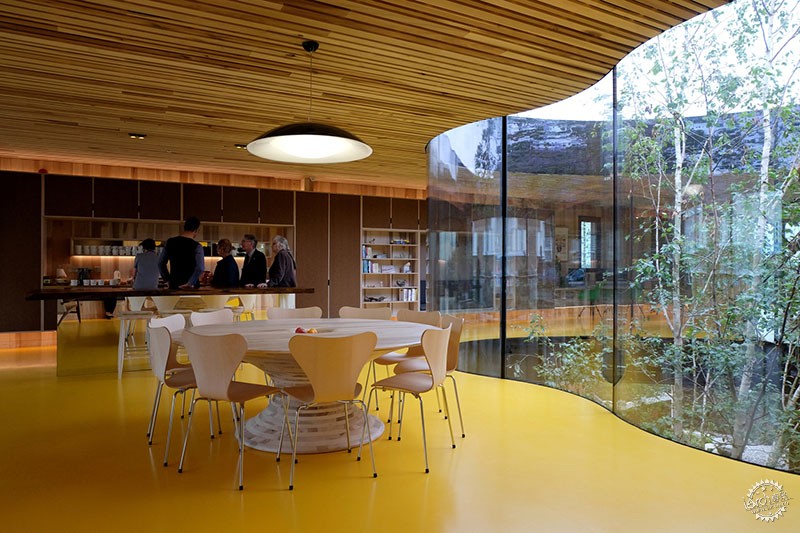
Maggie’s Oldham / dRMM. Image © Jasmin Sohi
在文章的开头,我提及这样一个事实,那便是老年人自身存在着诸多不同,而且有许多不同的功能水平。注定自我意识想要独居的老年人和残疾人的房子是不同的。的确,有些损失对所有人来说都是常见的,例如视觉、听觉、嗅觉、味觉等方面的感官损伤。肌肉、结缔组织、神经、心肺、肠胃和泌尿生殖系统等功能也会受到影响,那么事情就变得复杂了许多。每位老年人或多或少都有一些健康问题,因此并不需要针对每个问题进行微观设计。
在网站中,我发布了一款电子书,其中提及老年人的基本住宅设计清单,其中包含了许多可由使用者自行决定的轻微的设计调整。
- 没有阴影区域的均匀照明;
- 工作区域的额外照明设施,例如书桌、书柜等;
- 哑光平整的防滑地面;
- 能容纳轮椅和两个人并行的走廊;
- 重要的位置,比如卫生间和走廊设置扶手设施;
- 较长步行距离中的休息区域;
- 保持道路的通畅,无电线、家具等障碍物;
- 少用地毯;
- 高度适中的家具和橱柜。
如果建筑师希望在方案中清晰地表达设计理念,那么最好的方式便是和使用者进行沟通与交流。
Katz指数用于评判基本日常活动的依赖程度,其中有洗澡、穿衣、如厕、下床、坐在椅子上、进食等活动的评估。
在一般建筑的设计中,前面的小贴士也许很有用,但是针对老年群体则有特定的局限性,例如阿尔茨海默病或帕金森综合征,在设计时,建筑师应当先了解这些症状。
In the beginning of the article I mentioned the fact that the elderly population is different within itself and that there are many different levels of functional ability. A house destined to a completely independent person is very different from one for a disabled person. It is true that some losses are common to all, particularly those that affect the senses, like sight, hearing, tact, smell, and taste. The muscular, connective, bony, neurological, cardiopulmonary, gastrointestinal and genitourinary systems are also affected. That’s where things get difficult. Each elder will have a different loss in every one of those systems. To design a house that answers to every loss is expensive and unnecessary.
In this website, I provide an e-book with a basic checklist for designing homes for the elderly. It broadly covers the mild losses and can be done by the owner.
- Uniform lighting with no shadow areas.
- Extra lighting in work areas, such as desks and counters.
- Matte leveled anti-slipping floors.
- Wide corridors, enough for the circulation of a wheelchair and two people walking side-by-side.
- Grab bars in strategic places such as bathrooms and corridors.
- Resting areas when there are great lengths to be walked.
- Keep passages free of obstacles such as loose wires, toys, furniture, and low objects.
- Avoid using carpets.
- Furniture and cabinets at an appropriate height.
If the architect wishes to be more precise in their decisions, speak with the user to understand what their biggest challenges are.
Katz index is a great tool to evaluate the dependence degree in basic daily activities, the 'ABVD', where activities such as bathing, dressing, toileting, transferring from the bed to a chair, continence, and feeding are evaluated.
In situations where the architect is designing for a general public, the former tips may help, but if the elder or a group of elders has a specific limitation such as Alzheimer, for instance, or Parkinson, it will be necessary to learn more about the disease.
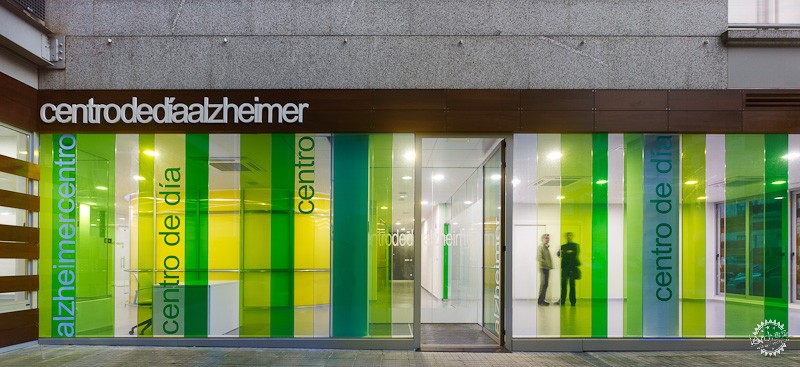
Alzheimer Day Care Center / Cid + Santos. Image © Santos-Díez BISimages
例如,如何为阿尔茨海默患者设计住宅?来自荷兰的建筑师则为这些患者构思了Dementia村落,这个封闭社区包含有住宅、广场、商店,其中每座建筑都面向广场开放,并且都有独特的风格特征,这里共7座建筑,有的建筑经典一些,有的现代一些。其中的广场也各不相同,这有助于创造城市和基础设施的自身活力,居住者可以自由地去往任何场所。在这里,服务人员不需要穿工装,只需接受培训并为老人们带来帮助即可。该项目最有趣的部分便是在保证安全的前提下,让老人们保留自身的独立性。另外,这里的剧场和餐厅面向公众开放,而周边社区也共用这些空间,这样能够有效地减少空间的封闭性。
那么,建筑师怎样才能超越仅仅只作为设计功能的束缚?建筑师们首先要感知人们对于使用空间的觉知与需求,同时帮助促进老年人们的独立自主性,及其空间的使用尊严。在这个时候,建筑的时候比以往任何时候都更有意义,这能够提升老年人的生活质量,让他们以最佳的方式继续活在当下。
参考文献
[1] KALACHE, A. & KELLER, I. (2000). “灰色的世界:21世纪的挑战”. 科学进程 83 (I), 33-54.
[2] 世界卫生组织. Envelhecimento ativo: uma política de saúde. Tradução Suzana Gontijo. – Brasília: Organização Pan-Americana da Saúde, 2005. 60p.:Il
[3] http://interscity.org/apps/acessibilidade/
[4] http://www.prefeitura.sp.gov.br/cidade/secretarias/saude/noticias/?p=247751
[5] 世界卫生组织. 城市的老龄友好标准——核心功能使用指南. Geneva. 2015. 120p.
[6] http://www.who.int/ageing/publications/Age_friendly_cities_checklist.pdf
[7] BACHELARD, G. A poética do espaço. 圣保罗: Martins, 2008
[8] CSIKSZENTMIHALYI E ROCHBERG-HALTON, 1981, p.9
How do you design a home for someone with Alzheimer? A group of architects from the Netherlands developed the Dementia Village with this scenario in mind. An entire neighborhood, with houses, squares, and stores for elders who share this type of dementia. It is an enclosed community. All the houses open to squares and every group of houses has its own style. There are seven in total. Some more classic, some modern… whichever style the owner prefers. The squares are also different among themselves. This helps to create the natural dynamic of cities and facilitates orientation. The dweller is free to go anywhere. The workers don’t wear uniforms and are trained to help them. The most interesting part of this project is that this configuration allows the person to keep their independence and autonomy, but with safety. Another interesting point is that the theater and the restaurants are open to the public. They divulged the initiative and the neighboring communities have adhered to the space, which helps to give it less of a confined and institutional atmosphere.
See how an architect’s role goes beyond designing an accessible bathroom or an adequate ramp? The architect plays a fundamental part in the perception that the dweller will have of the space. The architect can and must help to promote the elder’s autonomy, independence, and provide dignity in the use of the space. More than ever the role of architecture becomes relevant, helping to bring a better quality of life so that elderly people can continue to live the present moment in the best possible way.
Notes
[1] KALACHE, A. & KELLER, I. (2000). “The greying world: a challenge for the 21st century”. Science Progress 83 (I), 33-54.
[2] World Health Organization. Envelhecimento ativo: uma política de saúde. Tradução Suzana Gontijo. – Brasília: Organização Pan-Americana da Saúde, 2005. 60p.:Il
[3] http://interscity.org/apps/acessibilidade/
[4] http://www.prefeitura.sp.gov.br/cidade/secretarias/saude/noticias/?p=247751
[5] World Health Organization. Measuring the age-frinedliness of cities: a guide to using core indicators. Geneva. 2015. 120p.
[6] http://www.who.int/ageing/publications/Age_friendly_cities_checklist.pdf
[7] BACHELARD, G. A poética do espaço. São Paulo: Martins, 2008
[8] CSIKSZENTMIHALYI E ROCHBERG-HALTON, 1981, p.9
|
|
